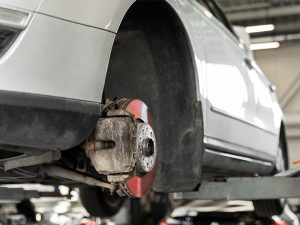Table of Contents
- Preparing Your Tools and Workspace
- Safety Measures
- Removing the Worn Brake Parts
- Installing New Brake Components
- Testing and Finishing Up
Preparing Your Tools and Workspace

To successfully service the brakes on your car, you must first gather all necessary tools and materials and establish a clean, organized workspace. This preparation not only enhances efficiency but also ensures safety throughout the process.
Tools and Materials Needed
| Tool | Purpose |
|---|---|
| Jack and Jack Stands | For lifting and securely holding the vehicle |
| Wheel Chocks | To prevent vehicle movement |
| Wrench Set | Removing and fitting bolts |
| C-Clamp or Brake Caliper Tool | Compress brake piston |
| Brake Fluid | Essential for the brake system |
| New Brake Pads/Shoes | Replacement for worn parts |
| Cleaner Spray | Degreasing brake components |
Safety Measures
Before diving into brake servicing, adhere to these crucial safety measures:
Safety Checklist
- Ensure the car is on a flat surface and use wheel chocks to prevent roll-off.
- Always use jack stands after lifting the car with a jack.
- Wear protective gear: gloves, goggles to avoid contact with brake dust and fluid.
- Disconnect the car battery to prevent any electrical shorts.
Removing the Worn Brake Parts

Now that you’re prepared, follow these steps to remove the worn brake components:
- Loosen the lug nuts slightly before jacking up the car.
- Lift the car using the jack and place jack stands under the vehicle for safety.
- Remove the wheel to access the brake components.
- Carefully remove the brake caliper. Ensure to hang it using a wire to avoid stressing the brake line.
- Take out the old brake pads or shoes, noting their positions for reference.
Installing New Brake Components
With the old parts removed, it’s time to install the new components:
- Clean the caliper and rotor with a brake cleaner to remove dust and grease.
- Compare the old parts with new ones to ensure correct replacement.
- Install the new brake pads or shoes in reverse order of removal.
- Use the C-clamp to compress the caliper piston, allowing room for new brake pads.
- Secure the caliper back onto its mount, ensuring all bolts are tightened properly.
Testing and Finishing Up
After installing the new brake components, perform these final checks:
- Reattach the wheel and lower the vehicle safely to the ground.
- Tighten the lug nuts in a crisscross pattern to ensure uniform pressure.
- Reconnect the car battery and start the car to test the brakes.
- Softly press the brake pedal several times to seat the brake pads correctly.
- Perform a cautious road test in a safe, open area to ensure brakes are functioning correctly.
Reference
For a detailed tutorial with additional tips, refer to our comprehensive guide on servicing brakes here.